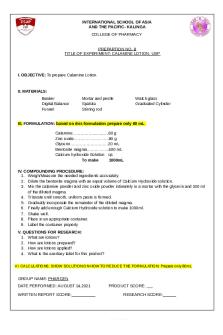Report Writing notes CEN 220 T PDF

| Title | Report Writing notes CEN 220 T |
|---|---|
| Course | Communication 2 |
| Institution | Tshwane University of Technology |
| Pages | 2 |
| File Size | 62.9 KB |
| File Type | |
| Total Downloads | 45 |
| Total Views | 146 |
Summary
Notes for writing a report...
Description
REPORT WRITING DEFINITION A report is a well-structured, objective, informative document or presentation. It is used to give the reader or listener information on a specific subject. CHARACTERISTICS OF A REPORT A report: is based on a systematic investigation of a specific event or situation. is requested by and is written for a specific person or organisation. may vary in length. may be formal or informal depending upon its purpose. presents facts in an accurate, objective and logical way, with the use of full sentences. has a specific structure. may have a legal purpose (police, accident reports). is mostly written in formal language. REQUIREMENTS FOR EFFECTIVE REPORT WRITING Correct layout. Objective reporting – Avoid:
I, we, you – use: he, she, they. Refer to yourself as ‘the writer, compiler or the undersigned’. humour and exaggeration bias or prejudice emotional words or expressions.
Be clear and concise and report relevant facts accurately. Use simple, clear and formal language. Use the past tense and indirect speech. Recommendations, however, are written in the future tense.
As an employee, you might be required to write a report for any of the following reasons:
to evaluate a specific situation (accident at work; complaints about an employee’s work); to keep management informed about the status of an employee’s work – quality, quantity and progress; to exchange ideas within an organization; to introduce and implement new ideas; to evaluate performance of staff for promotion opportunities; and to provide an analysis on the financial state of a branch or company.
TYPES OF REPORTS MOST OFTEN USED
Accident report (industrial, traffic, etc) Feedback report Progress report Investigative / formal or schematic report
FORMAL OR SCHEMATIC REPORT The writer: 1 is asked to carry out an investigation into a particular situation on behalf of another person (TERMS OF REFERENCE);
2 3 4 5
then carries out research and lists the methods and steps he took to get the necessary information (PROCEDURE); presents the information he discovered (FINDINGS); draws logical conclusions from his findings (CONCLUSIONS); makes suggestions based on the conclusions (RECOMMENDATIONS).
STRUCTURE OF SCHEMATIC OR FORMAL REPORT: TITLE Report on ……… 1
2
2.1 2.2 2.3 2.4 3
TERMS OF REFERENCE Date on which instruction was given, name and designation of person who requested the report, what is to be investigated, whether recommendations were required, date of completion. PROCEDURE Give METHODS used to gather information, but not the information gleaned. Possible methods include: Interviews Meetings Inspection Observation FINDINGS Records the information obtained from the procedures - facts only - no decisions or opinions are included. This is the longest section and should take up half of the final report. Headings and sub-headings can be used.
Examples of findings 3.1 50% of staff members interviewed experienced difficulties with the new computer program. 3.2 Only one day was spent on training and no time was allowed to practise new techniques. 3.3 All staff received the same training irrespective of the level of expertise. 4
CONCLUSIONS These should be drawn from Findings and reflect the writer’s interpretation OF FACTS. Unlike Findings, these are general and no new information is to be given in this section.
Example of a conclusion (based on the findings in 3.1-3.3) 4.1 Members of staff had not received adequate training in the use of the new computer program. 5
5.1
RECOMMENDATIONS Contains the writer’s suggestions on how to solve or remedy the problem. Should be plausible and drawn from conclusions and findings. They need to be specific. Example of a recommendation (based on the conclusion in 4.1 and the findings in 3.1-3.3) Staff members who require training should be identified immediately.
SIGNATURE OF COMPILER DESIGNATION DATE WHEN COMPLETED (Approximately 3 weeks from date of instruction) (An undated and unsigned report is valueless)....
Similar Free PDFs

Report Writing notes CEN 220 T
- 2 Pages

Report Writing Notes
- 2 Pages

Report Writing - Lecture notes 4
- 4 Pages

Report Writing - Incident Report
- 12 Pages

BISC 220 Lab Report 1
- 10 Pages

L T NIT Report
- 78 Pages

PREP 8 Calamine- Phar Cen
- 7 Pages

Article Report Writing - G4
- 5 Pages

All Report Writing Lectures
- 97 Pages

Report writing-Unit-22
- 24 Pages

Business Report Writing Skills
- 78 Pages

Sample report of writing
- 27 Pages

FHT Writing Report Guide
- 84 Pages

Report writing blah
- 2 Pages
Popular Institutions
- Tinajero National High School - Annex
- Politeknik Caltex Riau
- Yokohama City University
- SGT University
- University of Al-Qadisiyah
- Divine Word College of Vigan
- Techniek College Rotterdam
- Universidade de Santiago
- Universiti Teknologi MARA Cawangan Johor Kampus Pasir Gudang
- Poltekkes Kemenkes Yogyakarta
- Baguio City National High School
- Colegio san marcos
- preparatoria uno
- Centro de Bachillerato Tecnológico Industrial y de Servicios No. 107
- Dalian Maritime University
- Quang Trung Secondary School
- Colegio Tecnológico en Informática
- Corporación Regional de Educación Superior
- Grupo CEDVA
- Dar Al Uloom University
- Centro de Estudios Preuniversitarios de la Universidad Nacional de Ingeniería
- 上智大学
- Aakash International School, Nuna Majara
- San Felipe Neri Catholic School
- Kang Chiao International School - New Taipei City
- Misamis Occidental National High School
- Institución Educativa Escuela Normal Juan Ladrilleros
- Kolehiyo ng Pantukan
- Batanes State College
- Instituto Continental
- Sekolah Menengah Kejuruan Kesehatan Kaltara (Tarakan)
- Colegio de La Inmaculada Concepcion - Cebu

